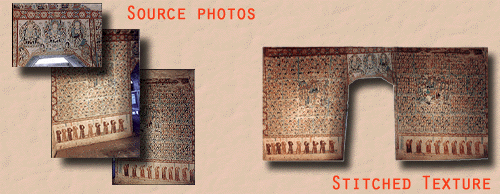Creating 3-D models requires many hours of careful image processing and modeling from high quality photography and cave geometry. Our current prototypes demonstrate the potential, but are limited by available photography and architectural drawings. Rectilinear photography of the cave surfaces and accurate cave geometry is needed for high quality models. Technical staff are working with researchers in planning extensive on-site photography for both surface imagery and photogrammetric analysis. Once the appropriate photography is obtained, significant image processing and object modeling hours will be invested to finish each 3-D model.
The 3-D Modeling Process

These photographs show the east wall of cave 196. Because these were not shot perpendicular to their surface, they first require parallax correction. They are then scaled and stitched into a single texture. The stitched texture is then ready for mapping onto its surface of the 3-D model. This example also demonstrates the need for consistent lighting during photography in order to avoid having to perform excessive color correction during texture assembly.
The geometry data for these 3-D models was developed from architectural drawings of the cave, then iteratively refined in a modeler with line and surface information obtained from the photographs. We are currently experimenting with photogrammetry software to aid in the development of accurate geometry information for the models. Once the model is created, the image textures are mapped to their appropriate surfaces.
Click and drag within the image to view the panorama.
QTVR 3.0 required.
Once the 3-D model is finished, it can be used in a variety of ways. 2-D images of specific perspectives can be rendered for WWW, slide, or print publication. The interactive 3-D model itself can be viewed on the WWW with VRML. Or an interactive panoramic rendering can be viewed with QuickTime VR. We show here, a QTVR panorama as an effective and easy-to-use way to display a single room 3-D environment on the WWW.
The prototypes that you see here were developed by graduate students under technical staff supervision. Digital media and 3D modeling facilities at Northwestern University as well as the academic programs they serve, provide an accomplished pool of digital media artists and modelers for production of cave-shrine models.See also Dunhuang Cave 285.